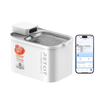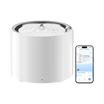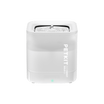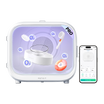Automatic cleaning litter boxes have gained popularity for their convenience, reducing the need for daily scooping and making pet care easier, especially for those with busy schedules or physical limitations. However, if you use an automatic cat litter box without health monitoring, you may be missing a critical aspect of pet care, which is monitoring your cat's stool, urine, and toileting behavior. If you don't check your cat’s litter box every day, or you don't know what they are doing when they are in there, then you could be missing important clues that impact your cat’s health, longevity, and well-being.
In this article, we will discuss why many veterinary experts caution against using automatic litter boxes that lack detailed health insights. While traditional automatic litter boxes offer basic monitoring, they may not provide the comprehensive view needed by some cat owners.
We will also explore the importance of closely monitoring your cat's daily elimination patterns for a more thorough analysis of your cat's well-being, especially with the help of visual data capabilities. Additionally, we will examine how AI-powered litter boxes are helping pet owners catch and prevent problems earlier.

Why Veterinary Professionals Don't Recommend Automatic Litter Boxes Without Detailed Health Insights
Most cat owners live busy lives, and it is easy to see why automatic cleaning litter boxes are so popular: they reduce the amount of time spent scooping and cleaning, they reduce odors associated with dirty litter boxes, they make it easier for people with physical limitations, and they allow pet parents to take a few days leave away from their cat. Most savvy pet parents know that cats prefer consistently clean litter boxes, and an automatic litter box makes it easier to keep a clean box. These conveniences are obvious and make our lives better, but do they actually improve the lives and health of cats?
In reality, despite their allure to pet parents, most veterinary professionals don't recommend automatic cleaning litter boxes, especially those that don't provide health insights. One of the most important reasons is that people who have an automatic cleaning litter box typically have less awareness about the elimination patterns of their cat. It is easy to see why: the box cleans away stool and urine so the pet parent never sees it or thinks about it.

While we as people prefer having our cat's stool and urine whisked away and taken care of, if a cat is having gut or urinary problems then we can miss important evidence such as loose stool or excessive urination that signify underlying health problems. This can lead to unnecessary pain and suffering, high vet bills, and negatively impact the health and longevity of your cat.
In addition to monitoring what a cat leaves in a litter box, it is also important for cat owner to be aware of their cat’s toileting behaviors, including how often they visit the box, how long they are in the box, if there is any competition or bullying for litter box time in multi-cat households. This is important especially if a cat is having accidents in the house, which is one of the leading behavioral reasons why cats are relinquished to shelters. People with basic automatic cleaning litter boxes are often unaware of what their cat is doing when they are in the box, which is another reason why veterinary professionals usually don't recommend them, especially for those cat owners who need a more comprehensive view.

What Pet Parents Can Learn by Monitoring the Litter Box
While some automatic litter boxes on the market already provide basic health monitoring, such as tracking weight changes over time, toileting frequency, and duration, this level of monitoring might not be sufficient for some cat parents. More advanced solutions can serve as valuable preventative tools. By monitoring your cat’s toileting behavior and elimination patterns visually, you can gain a wealth of information about the physical and mental health of your cat. This is important not only for disease prevention, but also to prevent behavioral problems such as aggression or house soiling.
Here are ten things that can be noticed about the health of a cat by monitoring litter box deposits and behavior:
I. Urinary Inflammation
Lower urinary tract inflammation due to stress and anxiety is a problem seen in many indoor cats. It is also known as feline interstitial cystitis and feline lower urinary tract disorder. This condition causes pain, and cats with this condition often exhibit bloody urine, straining to urinate, hiding, and house soiling.
II. Urinary Blockage
Obstruction of the urethra with mucus plugs or urinary stones is a problem most often seen in adult male cats. Cats with this condition exhibit straining to urinate while producing very little or no urine. They may vocalize due to pain. This is an emergency condition, as a blocked urethra can cause the bladder to rupture.
III. Diarrhea and Soft Stool
Cats with diarrhea may act otherwise normal when not in the box, and diarrhea or soft stool can be missed if the pet parent isn't actively monitoring the box. In addition, it can be difficult or impossible to tell who is having diarrhea in a multi-cat household where multiple cats use the same box.
IV. Bloody Stool and Worms
Cats can be infected with several types of intestinal parasites, several of which are also contagious to humans. Pet parents should monitor their cat's stool for worms and seek veterinary treatment if noticed. In addition, worms and other conditions can cause bloody stool that can manifest as either stool that contains bright, red undigested blood (signifies a lower GI bleed) or tarry, black stool that contains digested blood from a bleed in the upper GI tract.
V. Constipation
This condition results in dry, hard stool and can be caused by many things, including dehydration. Constipation can proceed to obstipation, which is a condition where a cat's colon becomes obstructed with hard stool. Obstipation causes excessive straining in the litter box with little or no stool produced, and can cause irreversible damage to a cat’s colon.
VI. Osteoarthritis
Monitoring your cat's toileting behavior can also tell you if a cat is experiencing pain getting into or out of the box, which is common in older cats that are suffering from osteoarthritis. Sometimes, the only sign of osteoarthritis in a cat is house soiling, as the cat is too painful to get into and out of the box.
VII. Litter Box Competition in Multi-cat Households
Households that have multiple cats without enough clean litter boxes can result in competition to use the box. This can result in stress and anxiety which can manifest as house soiling or increased aggressive or reclusive behaviors in cats.
VIII. Litter Box Aversion
Some cats are very particular about the type of box, the location of the box, and the type of litter in the box, and if they don't like any of it, they will choose to 'do their business' elsewhere in the house. Monitoring your cat's toileting behavior can let you know whether they are happy with the box or not.
IX. Excessive Urination
Several diseases cause cats to drink more and consequently pee more. Kidney disease, hyperthyroidism, and diabetes are some of the more common diseases that cause excessive thirst, urination, and dehydration. It can be difficult to determine who is urinating excessively in a multiple-cat household if you aren't actively monitoring the litter box. If a cat is urinating excessively, it is important to get them checked by a veterinarian as soon as possible to resolve the problem.
X. Inter-Cat Relationship Problems
Cats that live together in a home can sometimes have relationship problems such as bullying or competition for the litter box. This can lead to house soiling and increased aggression. Monitoring how cats cooperate or fight to use the litter box is important for preventing stress, anxiety, and behavioral problems.

Introducing the PUROBOT ULTRA: Bridging the Gap with AI Technology
Fortunately, technology is now available that addresses the limitations of regular automatic litter boxes by integrating advanced AI technology. The PUROBOT ULTRA is the first automatic litter box on the market equipped with an AI-powered camera that not only monitors your cat's litter box behavior but also records stool and urine images before the litter is clumped and discarded. This innovative feature elevates traditional automatic litter boxes to a new level of pet care, providing both convenience and crucial in-depth health monitoring. Features include:
- AI Camera with 180-Degree Auto-Tracking: Captures high-quality images and video clips of your cat's litter box activities, offering a detailed visual record of their stool and urine before the waste is processed.
- Stool and Urine Monitoring: The AI camera monitors the color, consistency, and size of the stool and urine clumps, alerting you to signs of constipation, diarrhea, hematuria, and other health issues. These images are stored in the app's timeline, where you can compare them with a stool health check chart, helping you pre-screen for potential pet diseases.
- Real-Time Health Insights: In addition to basic metrics like weight changes and toilet frequency, which many automatic litter boxes already track, the PUROBOT ULTRA provides real-time updates on your cat’s bathroom behavior and health, ensuring you don’t miss any critical signs.
- Convenient for Busy Lifestyles: For those with busy schedules or physical difficulties, the PUROBOT ULTRA offers the perfect balance between convenience and comprehensive health monitoring, eliminating the need to compromise your cat's health report card for ease of use. With 20 days of free scooping and a total touch-free waste management system, it provides an effortless solution that ensures your cat’s litter box stays clean and your pet's health is closely monitored.

As a veterinarian, I believe this product can bridge the gap between the convenience of modern pet care and the need for thorough health monitoring. It offers a visual report card that allows for easy daily records and comparison over time. This product ensures that cat owners no longer have to compromise on their pet's health insights for the sake of convenience. I believe this product is an excellent tool for pet parents who wish to catch diseases early, prevent behavioral problems associated with litter boxes, and enjoy the convenience of automatic cleaning with the peace of mind that monitoring provides.
About Sarah Wooten
Dr. Sarah Wooten, DVM, a graduate of UC Davis School of Veterinary Medicine (2002), is an internationally recognized influencer in veterinary and animal health care. With 16 years in private practice and over 10 years in veterinary media, she is a certified veterinary journalist. Dr. Wooten has contributed to several pet-related outlets, including Cats.com, VetStreet and PetMD, leveraging her expertise to educate a wide audience on animal health matters.




























